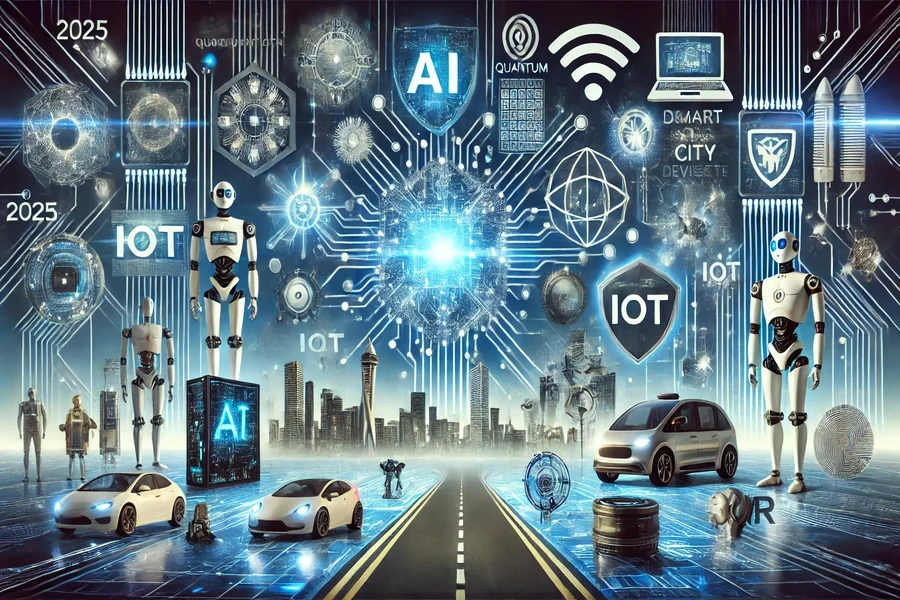Technology is moving faster than ever, blurring the line between science fiction and reality. What once seemed like futuristic fantasy—AI assistants handling our meetings, cities running on clean energy grids, virtual classrooms teaching students worldwide—is now at our fingertips. In 2025, several key technology shifts are not just transforming industries but reshaping how we live, communicate, and work.
From wearable devices tracking health in real time to quantum computing solving complex problems in seconds, the future is unfolding before our eyes. These developments carry both opportunity and responsibility, demanding that we adapt quickly while thinking critically about their impact.
Here are seven genius technology trends defining our immediate future—and what they mean for you.
Trend 1 – Artificial Intelligence in Everyday Life
Artificial intelligence (AI) is no longer a behind-the-scenes player—it’s in our homes, offices, and even creative spaces. AI-driven personal assistants schedule meetings, sort emails, and provide shopping recommendations tailored to your habits. Machine learning models predict health patterns, detect potential diseases early, and suggest preventive measures before symptoms even appear.
Content creation tools powered by AI are enabling writers, designers, and marketers to work smarter. Businesses are integrating AI analytics to forecast trends, manage supply chains, and improve customer experiences. However, this expansion sparks debate: can and should AI make decisions without human oversight? The rapid spread of generative AI raises questions about ethics, creativity, and job displacement, underscoring the need for strong AI governance.
In the coming years, AI will become even more personalized—learning from you and adapting to your unique preferences in ways we’re only beginning to understand.
Trend 2 – Quantum Computing Breakthroughs
For decades, quantum computing felt like a distant dream. Now, thanks to breakthroughs from companies like IBM and Google, it’s inching closer to practical use. Unlike classical computers, which process information in bits, quantum systems use qubits no deposit bonus 10 €, enabling them to solve complex problems in fractions of the time.
The implications are staggering: financial institutions could run millions of risk simulations instantly; drug researchers might design life-saving treatments at unprecedented speed; cybersecurity protocols could be tested against virtually unbreakable encryption—before real-world adoption.
Yet, quantum power comes with challenges. High costs, delicate cooling requirements, and the need for specialized expertise mean mass adoption is still years away. But the momentum is undeniable, and the ripple effect on science and business could be transformative within the next decade.
Trend 3 – 5G and the New Internet of Things Era
The arrival of 5G networks has supercharged the Internet of Things (IoT), connecting billions of devices with near-zero latency. From self-driving cars communicating with each other in milliseconds to smart factories optimizing production lines in real time, the possibilities seem limitless.
In healthcare, wearable monitors send vital signs straight to doctors, enabling early intervention for at-risk patients. In cities, traffic lights adapt to real-time traffic patterns to reduce congestion and lower emissions. Agriculture benefits too—5G sensors monitor soil conditions, ensuring precise water use and better crop yields.
While the rollout faces hurdles like infrastructure costs and cybersecurity risks, it represents a leap in efficiency, safety, and connectivity.
Trend 4 – Rise of Wearable Technology
Once a novelty, wearables have evolved into sophisticated personal health and productivity tools. Fitness trackers now monitor heart rate variability, oxygen saturation, and even detect irregular heart rhythms.
Businesses see potential too—smart glasses enable technicians to work hands-free with real-time visual instructions, while AR-enabled helmets improve safety on industrial sites. The next wave of wearables will integrate seamlessly into clothing and accessories, making them almost invisible while delivering real-time feedback.
Wearable tech’s biggest hurdle remains adoption costs and privacy concerns, but consumer demand is pushing rapid innovation.
Trend 5 – Green Technology and Sustainability
Technology is at the forefront of the global sustainability movement. From solar fabrics woven into clothing to energy-storing bricks powering homes, innovation is helping fight climate change.
Cloud-based platforms enable companies to track their carbon footprint and develop cleaner operations. Electric vehicles are now mainstream, with charging stations becoming as common as gas stations. Cities are experimenting with vertical farms and AI-powered waste management to reduce environmental impact.
Sustainable tech isn’t just good for the planet—it’s proving to be good for business too.
Trend 6 – Immersive Reality: AR and VR
Augmented reality (AR) and virtual reality (VR) have progressed beyond gaming. Today, medical students practice surgery using VR simulations, retail customers “try on” clothes virtually before purchasing, and architects walk clients through digital building models before laying the first brick.
By overlaying digital information on the real world, AR enables workers to get step-by-step instructions without breaking focus. VR, on the other hand, offers complete immersion, perfect for training in hazardous or sensitive environments.
Challenges remain with hardware accessibility and motion sensitivity, but as devices become lighter and more affordable, adoption is set to skyrocket.
Trend 7 – Cybersecurity in the Age of Smart Everything
As our devices become smarter, so do cyber threats. Hackers target everything—from personal smart fridges to corporate cloud systems. AI-driven threat detection helps identify intrusions faster than human teams, while blockchain adds layers of security to transactions.
Cybersecurity skills are now among the most in-demand, prompting universities and training centers to expand their programs. Even online learning platforms gamify lessons, offering rewards such as a no deposit bonus 10 € to encourage engagement in cybersecurity challenges. This blend of education and gamification is making digital safety a more accessible topic for all.
Adapting to These Tech Trends
The pace of innovation can be overwhelming. To stay ahead, individuals must cultivate lifelong learning habits—taking advantage of free online courses, joining tech communities, and experimenting with new tools. Businesses should consider reskilling staff and investing in future-ready infrastructure.
More importantly, society must balance rapid adoption with ethical considerations—ensuring we use technology responsibly, inclusively, and sustainably.
Conclusion
2025 is proving to be a landmark year in technology. These seven trends are already shaping industries, economies, and personal lives in profound ways. By understanding them now, you’ll be better prepared for the changes still to come. The future will reward those who stay curious, adaptable, and willing to see technology not just as tools—but as catalysts for human progress.



